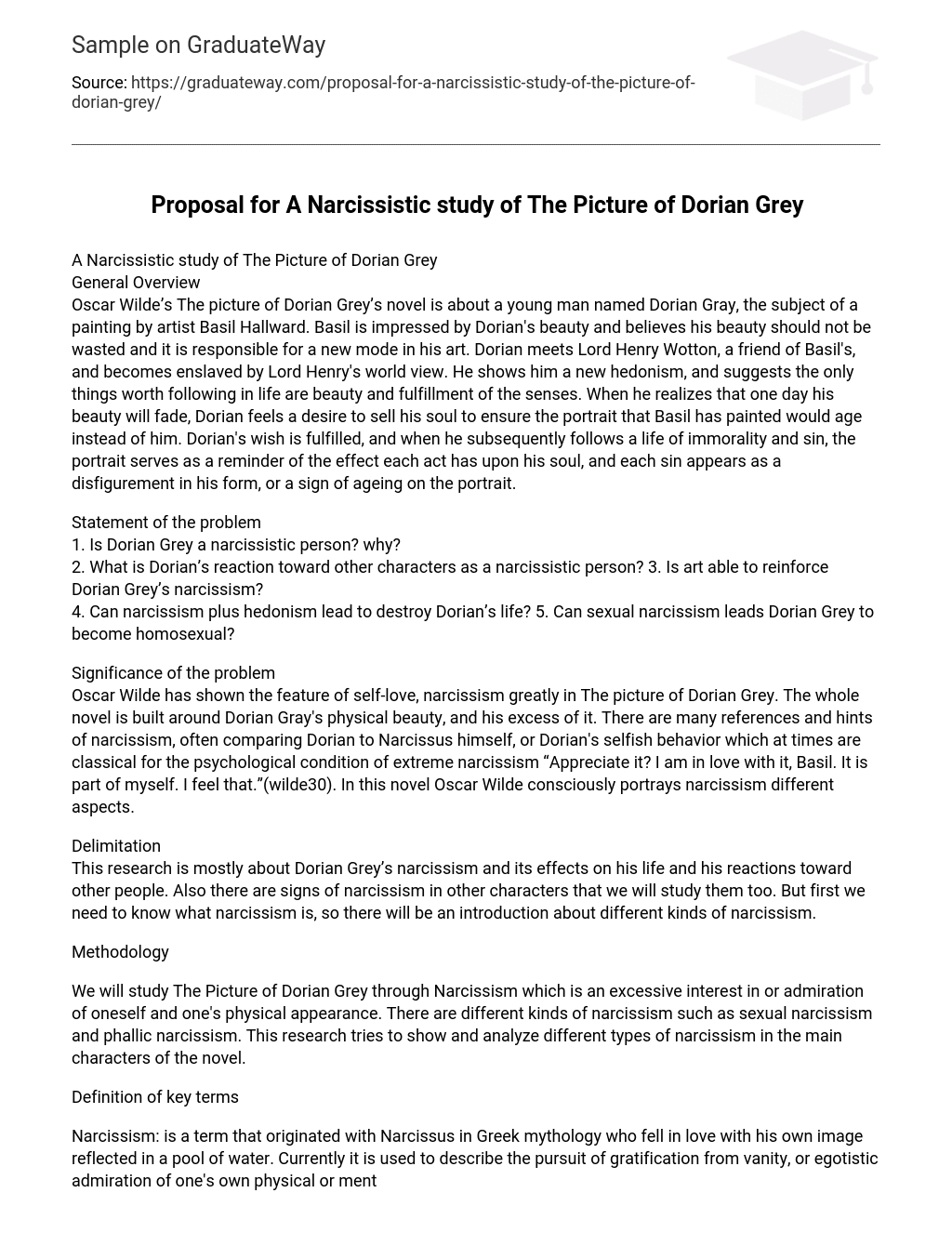The analysis of The Picture of Dorian Grey from a Narcissistic perspective reveals that Oscar Wilde’s novel revolves around the narrative of Dorian Gray, who becomes the subject of a painting by artist Basil Hallward. Basil is captivated by Dorian’s beauty and believes it should not be wasted, inspiring a new artistic style. Dorian encounters Lord Henry Wotton, an acquaintance of Basil’s, who fascinates him with his viewpoint. Lord Henry introduces him to a hedonistic lifestyle that prioritizes beauty and indulging in sensory pleasures. Aware that his physical attractiveness will decline over time, Dorian desires to exchange his soul so that the portrait painted by Basil ages instead of himself. His wish is granted, and as he engages in a life of immorality and wrongdoing, the portrait serves as an enduring reminder of how each action impacts his soul. Each sin either alters his physical appearance or manifests as signs of aging on the portrait.
Statement of the problem
1. Is Dorian Grey a narcissistic person? why?
2. What is Dorian’s reaction toward other characters as a narcissistic person?
3. Is art able to reinforce Dorian Grey’s narcissism?
4. Can narcissism plus hedonism lead to destroy Dorian’s life?
5. Can sexual narcissism lead Dorian Grey to become homosexual?
The problem’s significance lies in Oscar Wilde’s exploration of self-love and narcissism in The Picture of Dorian Gray. Throughout the novel, Wilde focuses on Dorian Gray’s physical beauty and his excessive indulgence in it. There are numerous references connecting Dorian to Narcissus, as well as moments when Dorian’s selfish behavior reflects extreme narcissism traits. One instance is when Dorian expresses deep affection for his own portrait, claiming it is a part of himself. Through this novel, Oscar Wilde intentionally presents different facets of narcissism.
The primary objective of this study is to investigate the impact of narcissism on Dorian Grey’s life and relationships, while also delving into other characters who exhibit narcissistic characteristics. It is crucial to provide a concise overview of the different forms of narcissism before commencing our analysis.
Methodology
This study focuses on the exploration of narcissism in The Picture of Dorian Grey. It evaluates how the novel portrays various forms of narcissism, including an intense focus on oneself and an excessive preoccupation with physical attractiveness. The analysis encompasses the examination of sexual and phallic narcissistic behavior displayed by the primary figures.
The definition of significant concepts
The word “narcissism” originates from Greek mythology, in particular the tale of Narcissus. He became obsessed with his own reflection in a pool of water. In contemporary language, narcissism refers to the pursuit of self-approval and displaying arrogant admiration for one’s physical or mental attributes as a result of extreme pride.
Pathological narcissism, including narcissistic personality disorder, is characterized by an increased level of narcissism. This state involves the withdrawal of one’s libido from external objects and can lead to the emergence of megalomania.
Megalomania is characterized as a psychological disorder in which individuals possess unrealistic fantasies regarding power, significance, or omnipotence. This condition is distinguished by an exaggerated self-esteem and an intense conviction in one’s own capabilities and convictions.
Phallic narcissism refers to the qualities of someone who is elitist and desires social advancement. They seek admiration, promote themselves, boast about their accomplishments, and find empowerment through social success. Furthermore, individuals with phallic traits view sexual behavior as a means to exhibit power, whereas those with genital traits consider it a shared experience within a relationship.
The text explores the concept of sexual narcissism, which refers to a behavior pattern wherein individuals hold an inflated belief in their sexual skills and entitlement. They possess a strong desire to be superior lovers and seek partners who mirror them sexually. This dysfunction arises from low self-esteem and challenges in forming meaningful connections, often leading to pursuing extramarital affairs.
Dysmorphophobia is a somatoform disorder that is characterized as a chronic mental illness. It involves individuals who are preoccupied with their body image, displaying excessive concern regarding a perceived defect in their physical appearance.
Hedonism is a philosophical school of thought which asserts that pleasure is the sole intrinsic good. Simply put, a hedonist seeks to maximize overall pleasure, taking into account both pleasure and pain. Ethical hedonism maintains that everyone has the right to do whatever they can to attain the utmost pleasure achievable for themselves, and that their pleasure should greatly outweigh their pain. This ethical perspective is believed to have been initiated by Aristippus of Cyrene, a disciple of Socrates, who advocated that pleasure is the ultimate good.
Work cited
- The Picture of Dorian Gray (Penguin Classics) – Introduction
- Notes on The Picture of Dorian Gray – An overview of the text, sources, influences, themes and a summary of The Picture of Dorian Gray
- 2010 | Dublin: One City, One Book”. Dublinonecityonebook.ie. Retrieved 30 May 2011.
- The picture of Dorian Gray. Illustrated by Lui Trugo”. WorldCat. Retrieved 11 July 2012.
- Differences between the 1890 and 1891 editions of “Dorian Gray””. Home.arcor.de. Retrieved 30 May 2011.
- Symington, Neville (1993). Narcissism: A New Theory. H. Karnac Ltd. pp. 6–7. ISBN 9781855750470.
- Hedonism, 2004-04-20 Stanford Encyclopedia of Philosophy





